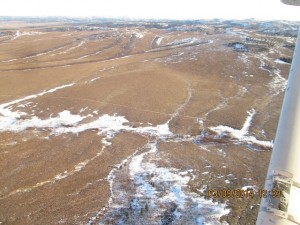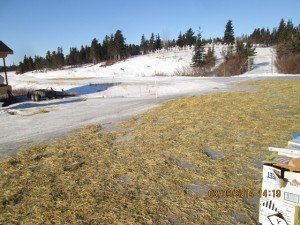March 9 1PM —Koyuk—Zirkle leads, King gradually gains
Our plane departed UNK about noon in warm weather for destination Koyuk. I debated putting on my big parka, thinking it would be much colder when we arrived Koyuk. We would follow the trail as it wound overland over the Blueberry Hills, then fall off a high ridge back to the ice and parallel a long sand spit leading west to Shaktoolik, standing defiantly on a high beach overlooking the Bering Sea on the south and a vast delta of fresh water and Norton Sound bay to the north.
Note the photo of the Blueberry Hills and see the trail ribbon running horizontal on the photo on brown tundra, imagining mushers bouncing on tussocks, downed timber and the occasional rocky slope. What a bizarre sight since we are accustomed to pure white.
From Shaktoolik the trail leads over a delta of grassland and low brush. In a storm it’s difficult to tell the difference between the sea and the land. About 15 miles out the trail passes by Lonely Rock, a solitary mini-massif that can be seen for miles, or at least that’s what I call it. On the aviation map it’s called Rocky Point. Beside it a shelter cabin provides relief for travelers. This year the trail follows the shore of Norton sound to avoid a jumble of wind blown ice. Normally, the trail goes straight as a survey line to Koyuk.
About 7 miles from Shaktoolik, at 11:55pm we see Mitch Seavey traveling very steadily. More or less, he is 3 hours to contact Jeff King. Two miles further we see Dallas Seavey, the 1x champ that is probably the fastest team on the trail today (as you know, the dynamics can change.) Six or so miles later we spot Sonny Lindner obviously closing on our third place team of Martin Buser. Martin’s team looks steady, but obviously not the steam of Lindner’s team.
A large gap separates this group from Jeff King, immediately recognized by his fast traveling team. Immediately, Bruce and I recognize that he has abandoned the caboose sled and is race mode. By our observation he is about two to three miles behind Zirkle. Our contacts following the little dots on the Iditarod tracker confirm that King has closed the gap to front runner Zirkle and that he appears to be steadily closing on Aliy.
The power of the wind to move massive pans of ice can be seen from the air. On the ground, local trailbreakers have moved the trail to the east side of Norton Sound, occasionally traveling on tundra, then following smooth ice, turning again to avoid another ice jam, and sweeping in an arc to Koyuk.
At the Koyuk checkpoint I ask locals about the trail where I get varying opinions from “It’s not so bad” to “a lot of ice, but some bare dirt.” One thing is for certain. The trail is longer than the traditional trail straight across the ice, maybe 60 miles.
The layer of ice on roads in Koyuk is absolutely a game changer. Everyone but kids, who like to skate with their shoes, walks with little penguin steps. One local guy told me,”We have more rain than snow this winter,” and I believe after walking on a glistening glazing of ice all the way from the airport to the checkpoint.
In front of the checkpoint, one conscientious veterinarian is hauling water and dampening a trail on the ice to the dog yard. Then, volunteers spread hay, which freezes to the ice. At least you can walk on it, but still have to be careful. The ice is treacherous and even with cleats in my boots I just about ate it on the ice a couple of times.
Locals wait to greet Aliy into Koyuk, but race pundits wonder how far King closed the gap.


































